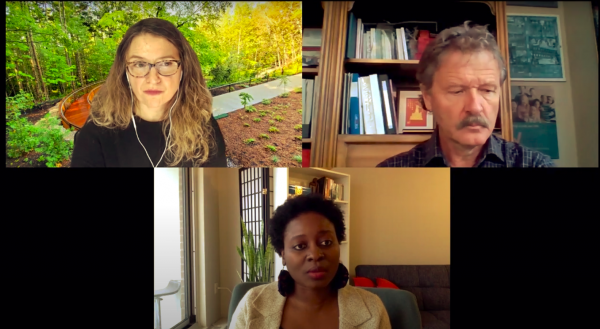EGL Webinar Summary: What Does a Just Transition Look Like in a Time of Pandemic?
Recap: What Does a Just Transition Look Like in a Time of Pandemic?
Global carbon lock-in and our established fossil-fuel dependency threatens us and many others, especially marginalized groups like the Indigenous peoples. The COVID pandemic has laid bare these issues, resulting in disparate outcomes with vulnerable communities often feeling the brunt of these impacts. Pursuing a just-transition provides opportunities to acknowledge and improve sustainability rooted in justice. This November 24thconversation included two speakers. Moderated by Teresa Karmarz (co-Director of EGL, Director of Munk One and Associate Professor at the Munk School of Global Affairs and Public Policy), the discussion centered around decarbonization, sustainability, and equity.

Speakers:
Nadège Compaoré, Assistant Professor of Political Science at the University of Toronto
John Cartwright, President of the Toronto & York Region Labour Council
To watch the full webinar, click on the link here.
Overview of the event:
The pandemic has exposed the impact of everyday inequity on vulnerable communities, as well as their limited capacities to respond to major shocks in terrifying detail. Our panelists discuss how a just transition to a low-carbon future can address these inequalities to make decarbonization a sustainable process that enhances justice, equity, and anti-racism for all.
Teresa Karmarz began by asking, what does a just transition look like at a time of multiple-intersecting crisis? The transition must account for global and local political economies that effectively export many social and environmental externalities to low-income countries and communities, whom bare these additional burdens. In the face of such an intricate network of issues, what are the social, environmental, and political implications of adopting one-off solutions to the climate solutions?
Nadège Compaoré focuses her discussion on the north-south dynamics in the global context of oil and gas industries, highlighting the challenges of a just-transition in the global south. Despite attitudes in the global north, Compaoré urges us to reconsider the false narrative that the global south is not interested in a just transition. She begins by discussing how the transition out of a deeply embedded carbon economy should follow a path that incorporates and considers the lives of marginalized communities. Especially important is the centering of local people in these discussions. Compaoré states that despite the pandemic and global economic crisis, big oil industry extractions have actually increased significantly in the south. She encourages the audience to consider global governance frameworks that look at north-south relations to rethink the question of a just-transition in the global context. Compaoré highlights that we must look at the timeline beforeextraction, including consulting, consent, and alternatives for communities that are affected by carbon and mining in their region. She ends with the note that we need to hear voices from every part of our economy talking about climate justice.
Next, John Cartwright, begins with the statement that while transition and change may be, justice in this process is not. He discusses that the struggle for health and safety of most trade union activists surrounds these issues of the climate and environment. He elaborates that the GTA is largely made of people of colour and women, in industries such as food production, and that these people cannot take time off and protect themselves amidst the pandemic. Cartwright then discusses that the concept of a just transition envisions a world that allows us to be in harmony. As we have witnessed, COVID-19 has laid bare our world’s horrific inequalities. Therefore, when we advocate for a greener economy, we don’t want to say jobs vs. environment, we can focus our advocacy on a just transition. Cartwright closes his discussion with the question, how do we shape an economy that works for all of us? Not just dreaming of an economy that was leaving far too many people behind.
Numerous discussions followed as the audience questioned policy responses concerning just transitions, what will continue to pose as obstacles to this message post-transition, how international organizations bridge the gap between domestic and global just transitions, and the possible impacts of political short-termism.
